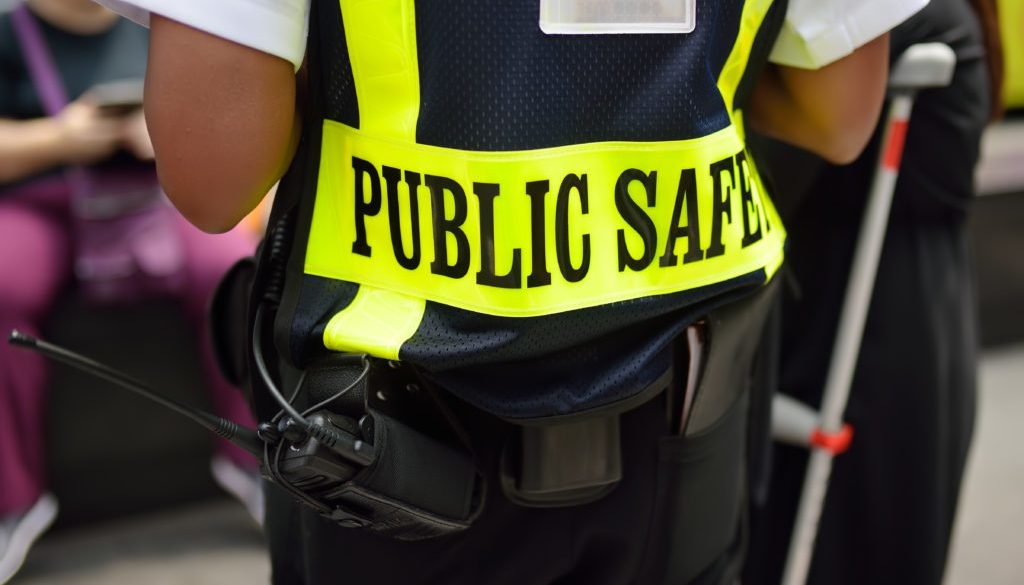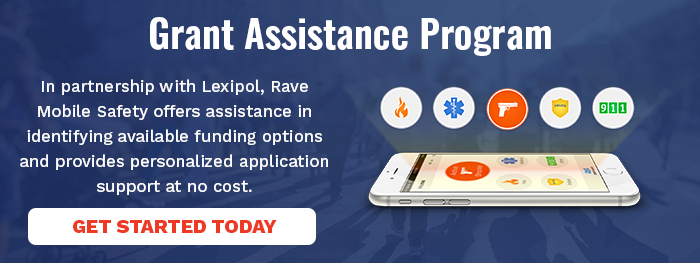Public Safety Grants Available Across the Country
For the latest funding programs available by state, please visit our School Safety Funding Guide.
Rave Mobile Safety has and continues to work with thousands of communities across the country to address the needs of first responders and critical community services. Public Safety Answering Points (PSAPs), better known as the centers that answer all 9-1-1 calls, have received increased spotlight due to personnel shortages and lack of funding after he initial outbreak of the COVID-19 pandemic, though this has been a critical issue for decades. Earlier this year, Rave released its 2022 Public Safety Trends Survey results. The findings reiterate this continued challenge that emergency responders, including 9-1-1 dispatchers, are experiencing increased challenges and workloads at their jobs and are in need of better tools and resources to improve response efforts.
The federal government and state legislatures alike have been trying to address these shortfalls through initiatives under Next Generation 9-1-1. However, funding continues to be in flux. As the battle continues, some states have taken the steps to invest more into PSAP operations. Some communities in states like Arkansas, Georgia, and Maryland have used CARES Act and American Rescue Plan Act dollars to invest into PSAPs. Additionally, Idaho, Iowa, New York, and Wisconsin have taken the torch to offer yearly programs to enhance PSAP capabilities, equipment, training, and personnel as can be seen below.
In the chart below, you can find the states that currently offer grants for PSAPs. The information is updated as information becomes available.
| State | Department/Agency | Program Name | Eligible Entities | Is Rave eligible? | Max $ Ask | Y/N Match | Is it open now? | If yes, list due date. | If not open, when will it open? |
| N/A | U.S. DOJ | The Kevin and Avonte Program: Reducing Injury and Death of Missing Individuals with Dementia and Developmental Disabilities | Healthcare agencies, public safety entities, and nonprofits | Yes | $150,000 | TBD | Yes | 3/27/22, 8:59 PM EST | N/A |
| ID | Office of Emergency Management | IPSCC Grant Program | County and local governments | Yes | TBD | TBD | No | N/A | 2023 |
| IA | Dept of Homeland Security | GIS Grant Funding | PSAPs | Yes | TBD | TBD | No | N/A | 2023 |
| NY | Homeland Security and Emergency Services | SICG-Formula Program | Counties | Yes | TBD | TBD | No | N/A | 2023 |
| NY | Homeland Security and Emergency Services | Statewide Interoperable Communications Grant (SICG) Targeted Program | Counties | Yes | TBD | TBD | No | N/A | 2023 |
| NY | Homeland Security and Emergency Services | Public Safety Answering Points (PSAP) Operations Grant | Counties | Yes | TBD | TBD | No | N/A | 2023 |
| WI | Office of Emergency Communications | PSAP Grant Program | Individual PSAPs | Yes | TBD | TBD | No | N/A | 2023 |
Rave continues to provide critical resources, information, and data on innovative techniques, tools, polices, and procedures to best equip communities for times of crisis. This will not only in the traditional first responder space. Just as critical is addressing the needs of excellent communications needed in the 9-8-8 space and between 9-8-8 and 9-1-1. Though new in operations, we are seeing the same issues in the rollout of 9-8-8 that were seen when 9-1-1 was implemented decades earlier. In Rave’s 2022 survey, most (72%) respondents believe first responders and mental health professionals together are best suited to respond to emergency situations involving mental health crises. Respondents also report their agencies are increasing training for first responders (52%), providing information about a person’s mental and physical health (39%) and establishing crisis intervention team programs (36%). In a post last month, Lauren Gonnelli addresses these specific communications concerns and possible solutions in regards to 9-8-8 as well as 9-8-8 and 9-1-1 interoperability.
Funding these critical initiatives have been partially seen. The federal government have made a couple of pots of funding accessible to states to develop, implement, and maintain 9-8-8 related services and communications, but more investment is needed to further the technological abilities necessary for both 9-1-1 and 9-8-8 to be the most optimal public services. States are tasked with making up the rest of the funding required for these services. The ability of each state to accommodate this task, however, is limited. The National Alliance on Mental Illness (NAMI) has a tracker that provides the progress being made in individual states for this initiative.
Emphasis must be put on the need for innovation is key in these spaces. A critical communication and collaboration platform is on the forefront of legislators and agency minds when it comes to what is next. These capabilities enable those on the front lines to improve how they collaborate and coordinate an emergency response. The consolidated platform provides a number of tools to have a better understanding of what’s happening on scene so dispatchers and emergency personnel can allocate an appropriate response. It also allows state and local government officials ways to engage their communities with an informed understanding of what their community needs at a given time.
Rave has seen the powerful impact that these tools and services have had on communities across the country. A couple of real examples in the past year:
- In 6 months, Ottawa County, Michigan has initiated 3,270 Chat sessions with mobile 9-1-1 callers in an attempt to resolve as many of the 5,141 dropped 9-1-1 calls as possible. Among the 3,270 chat sessions, 680 of them were resolved – that’s 13% of all dropped 9-1-1 calls.
- In Kern County, California, a 9-1-1 call came in from a resident who reported her friend was being held against her will inside her own home. The female victim felt too unsafe to call 9-1-1, so she texted a friend to call on her behalf. While gathering information on the emergency from the reporting party, the 9-1-1 dispatcher asked if she could text the female victim directly. The dispatcher hoped to communicate with the female through a direct line, but wanted the conversation to stay discreet from the male subject holding the woman captive. The dispatcher was then able to initiate a SMS texting conversation with the female and obtained first-hand information on the situation. It turns out the male subject was wanted on a felony warrant and had prior arrests for domestic violence. The female said there were other occupants, as well as informed 9-1-1 of possible weapons present in the home.
- In Carson City, Nevada, a man was driving late at night alone in a semi-rural area. He fell asleep at the wheel and got into an accident, injuring himself. When the man called 9-1-1, all that he knew was that he was somewhere between two towns, but not sure exactly where. The Carson City dispatch location services were down, so there was no way to get a location. Using the Rave 911 Suite, the telecommunicators were able to find his exact location, share it with law enforcement and send EMS to find him quickly.
Rave Mobile Safety has more dedicated resources to assist prospects and established customers in looking for funding opportunities to assist with purchasing Rave’s Critical Communication and Collaboration Solutions for PSAPs. For more questions about how Rave qualifies for these grants, please contact us!





